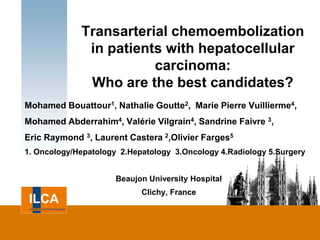
Transarterial chemoembolization in patients with hepatocellular carcinoma
- 1. Transarterial chemoembolization in patients with hepatocellular carcinoma: Who are the best candidates? Mohamed Bouattour1, Nathalie Goutte2, Marie Pierre Vuillierme4, Mohamed Abderrahim4, Valérie Vilgrain4, Sandrine Faivre 3, Eric Raymond 3, Laurent Castera 2,Olivier Farges5 1. Oncology/Hepatology 2.Hepatology 3.Oncology 4.Radiology 5.Surgery Beaujon University Hospital Clichy, France
- 2. BACKGROUND & AIM • Transarterial chemoembolization (TACE) is the most commonly used palliative treatment in patients with hepatocellular carcinoma (HCC) • However, identification of the best candidates who will benefit the most from TACE is still a matter of debate • The aim of this study was to analyze survival after TACE as well as prognostic factors in order to determine the optimal candidates for TACE
- 3. METHODS • All patients treated with conventional lipiodol TACE alone as first line treatment in our institution from January 2006 to October 2009 were retrospectively selected from a prospective database • For each patient, TACE was indicated after discussing all treatment options during our multidisciplinary HCC meeting • TACE was as selective as possible according to tumor size and tumor feeders • Clinical, biological, radiological data and tumor features were collected for all patients • Survival was estimated using the method of Kaplan Meyer and prognostic factors using Cox-model-based analysis
- 4. RESULTS • During the period of the study, 485 patients with HCC were treated in our institution. Among them, we selected for this study the 122 patients treated with TACE alone as first line treatment. • Patients characteristics were summarized in table 1 • Follow-up – After a median follow-up of 30.1 months, 52 (42.6 %) patients have died – The median overall survival after the first TACE was 30 months for the entire cohort (Figure 1) – The cumulative 12, 24 and 36 months survival rates were: 76.7%, 55.6% and 45%, respectively • Complications No treatment-related death was observed and only 2 patients (1.6%) experienced serious complications (liver abscess and cholecystitis each)
- 5. Table 1. Patients characteristics and tumor features Median age (Years) 64.7 Male – n (%) 122 (79) Etiology of underlying liver disease n (%) Viral C / Viral B 51 (41)/ 16 (13) Alcohol 33 (26) Other 25 (20) Child-Pugh score – n (%) Class A / Class B 98 (80) / 24 (20) Albumin – n (%) > 35 g/l/ < 35 g/l 98 (80)/24 (20) Bilirubin – n (%) < 35 µmol/l / > 35 µmol/l 111 (91) / 11 (9) Transaminase - n (%) <2N/>2N 67 (55) / 55 (45) Tumor stage BCLC- n (%) A/B/C 50 (41) / 63 (52) / 7 (9) Vascular invasion – n (%) Yes / No 11 (9) / 111(91) Number of lesions – n (%) ≤3/>3 56 (46) / 66 (56) Tumor diameter (cm) 3.6 ± 2.1 AFP – n (%) ≥ 20 UI/ml / < 20 UI/ml 63 (52) / 59 (48)
- 6. Figure 1. Kaplan–Meier estimated survival curve for the cohort After first TACE, median overall survival was 30 months
- 7. Univariate analysis • In univariate analysis, variables significantly associated with better survival were: Child-Pugh class A (p < 0.0003) viral etiology of cirrhosis (p < 0.01) transaminase ≤ 2 NL (p < 0.005) albumin ≥ 35 g/l (p < 0.01) AFP < 20 UI/ml (p < 0.05) bilirubin < 35 μmol/l (p < 0.001) and absence of vascular invasion (p < 0.03)
- 8. Multivariate analysis of the factors of survival • In multivariate analysis, better survival was independently associated with Child-Pugh class A, AFP < 20 UI/ml and absence of vascular invasion (table 2) Variables Hazard ratio (95% CI) P Child-Pugh class A 3.6 (1.72-7.40) p < 0.0004 4.7 (1.06 – 5.80) AFP < 20 UI/ml p < 0.009 Absence of vascular 3.7 (1.06 - 13.09) p < 0.03 inavasion
- 9. Best candidate to TACE in our serie • Patients with Child Pugh class A, normal AFP plasma level, without vascular invasion treated with TACE had better survival than patients without these criteria: > 40 months (30.1 – NA , 95% CI) vs. 28 months, (20.4 - 42.7, 95% CI; p = 0.03) (Figure 2)
- 10. CONCLUSION • TACE is a safe and well tolerated treatment • Careful selection of patients is mandatory to achieve survival benefit • Patients with compens ate liver function, normal AFP, without vascular invasion are the best candidates for TACE